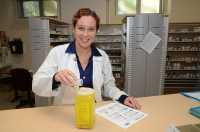Editor's note: Don't delay seeking advice from your health care provider with prolonger over-the-counter remedies. Some conditions, including but limited to persistent cough, gastrointestinal symptoms, headache etc may be a symptom of a more serious condition and should be evaluated by your doctor or provider.
Have you ever thought about how convenient it would be if your local pharmacy was just a few clicks away? Well, with the rise of online pharmacies, that's exactly the reality for many people. These digital services have become a practical solution for managing a wide range of health conditions. Whether you need professional advice or simply want the convenience of ordering treatments from the comfort of your own home, an online pharmacy can be a reliable and efficient partner in maintaining your health.
In today's fast-paced society, advancements in technology, changes in patient demographics, and shifts in healthcare policies are continuously reshaping the role of pharmacists. To stay relevant and effective in your profession, it's essential to stay ahead of the curve and adapt to these emerging trends.
 As a future pharmacist, you are positioned at the forefront of patient care, entrusted with ensuring the safe and effective use of medications. To fulfill this role effectively, you must remain informed and adaptable to the latest advancements in pharmacy practice.
Before delving into these trends, let’s first look at some relevant statistics. With the industry witnessing constant evolution, the demand for pharmacists continues to soar even more. In the first three quarters of 2023, there were about 60,882 job postings for pharmacists. This marked an increase of 17.9% from 2022, indicating a significant push in demand for these professionals.
The data from AACP’s Pharmacy Demand Report indicates that the time is opportune to enter the industry and gain a competitive edge. However, you must be aware of the prevalent trends to reap the benefits. Utilizing free MPJE practice questions can also help you prepare effectively for your licensure exam. In this blog, we'll explore a few essential trends that every aspiring pharmacist should know.
(more…)
As a future pharmacist, you are positioned at the forefront of patient care, entrusted with ensuring the safe and effective use of medications. To fulfill this role effectively, you must remain informed and adaptable to the latest advancements in pharmacy practice.
Before delving into these trends, let’s first look at some relevant statistics. With the industry witnessing constant evolution, the demand for pharmacists continues to soar even more. In the first three quarters of 2023, there were about 60,882 job postings for pharmacists. This marked an increase of 17.9% from 2022, indicating a significant push in demand for these professionals.
The data from AACP’s Pharmacy Demand Report indicates that the time is opportune to enter the industry and gain a competitive edge. However, you must be aware of the prevalent trends to reap the benefits. Utilizing free MPJE practice questions can also help you prepare effectively for your licensure exam. In this blog, we'll explore a few essential trends that every aspiring pharmacist should know.
(more…)
 As a future pharmacist, you are positioned at the forefront of patient care, entrusted with ensuring the safe and effective use of medications. To fulfill this role effectively, you must remain informed and adaptable to the latest advancements in pharmacy practice.
Before delving into these trends, let’s first look at some relevant statistics. With the industry witnessing constant evolution, the demand for pharmacists continues to soar even more. In the first three quarters of 2023, there were about 60,882 job postings for pharmacists. This marked an increase of 17.9% from 2022, indicating a significant push in demand for these professionals.
The data from AACP’s Pharmacy Demand Report indicates that the time is opportune to enter the industry and gain a competitive edge. However, you must be aware of the prevalent trends to reap the benefits. Utilizing free MPJE practice questions can also help you prepare effectively for your licensure exam. In this blog, we'll explore a few essential trends that every aspiring pharmacist should know.
(more…)
As a future pharmacist, you are positioned at the forefront of patient care, entrusted with ensuring the safe and effective use of medications. To fulfill this role effectively, you must remain informed and adaptable to the latest advancements in pharmacy practice.
Before delving into these trends, let’s first look at some relevant statistics. With the industry witnessing constant evolution, the demand for pharmacists continues to soar even more. In the first three quarters of 2023, there were about 60,882 job postings for pharmacists. This marked an increase of 17.9% from 2022, indicating a significant push in demand for these professionals.
The data from AACP’s Pharmacy Demand Report indicates that the time is opportune to enter the industry and gain a competitive edge. However, you must be aware of the prevalent trends to reap the benefits. Utilizing free MPJE practice questions can also help you prepare effectively for your licensure exam. In this blog, we'll explore a few essential trends that every aspiring pharmacist should know.
(more…)
Allergies, Author Interviews / 15.11.2019
Pharmacy Students Can Help Identify Patients Who Are Truly Penicillin Allergic
MedicalResearch.com Interview with:
Christopher M. Bland, Pharm.D., FCCP, FIDSA, BCPS
Clinical Associate Professor
Clinical and Administrative Pharmacy
University of Georgia College of Pharmacy
Clinical Pharmacy Specialist
St. Joseph’s/Candler Health System
Savannah, GA
MedicalResearch.com: What is the background for this study?
Response: Nearly 10% of the United States population self-report a penicillin allergy. However 90% of these allergies are found to be false upon reconciliation which includes patient interview, graded challenge, direct challenge, or penicillin skin testing. This is crucial as patients labeled with a penicillin allergy often receive more expensive antibiotics that additionally cause more adverse effects. While reconciling penicillin allergies is an important antimicrobial stewardship goal, resources are often limited in various healthcare settings to accomplish several of these endeavors.
Our study evaluated the use of pharmacy students to serve as patient interviewers to aid in reconciling penicillin allergies. (more…)
MedicalResearch.com Interview with:
Craig A. Pedersen, RPh, PhD, FAPhA
Manager, Sterile Compounding and Investigational Drug Service,
Pharmacy Clinical Professor
University of Washington
MedicalResearch.com: What is the background for this study?
Response: The ASHP national survey of pharmacy practice in hospitals originated with the Mirror to Hospital pharmacy, the first comprehensive, national audit of pharmaceutical services in hospitals, published in 1964. Since that time, ASHP has conducted national surveys to document practices and technologies for managing the improving the medication-use system and the role that pharmacist play in that effort. Beginning in 1998, the national survey became an annual project by ASHP. This survey provides important information to pharmacists, managers, and external stakeholders to document the current state of pharmacy practice. (more…)
Author Interviews, JAMA, Opiods, Pharmacology / 14.11.2018
Not All Pharmacies Have Naloxone for Opioid Overdose in Stock
MedicalResearch.com Interview with:
Talia Puzantian, PharmD, BCPP
Associate Professor of Clinical Sciences,
School of Pharmacy and Health Sciences
Keck Graduate Institute
MedicalResearch.com: What is the background for this study?
Response: Naloxone has been used in hospitals and emergency rooms since the early 1970s. Distribution to laypersons began in the mid-1990s with harm reduction programs such as clean needle exchange programs providing it, along with education, to mostly heroin users. In the years between 1996-2014, 152,000 naloxone kits were distributed in this way with more than 26,000 overdoses reversed (https://www.cdc.gov/mmwr/preview/mmwrhtml/mm6423a2.htm).
We have data showing that counties in which there was greater naloxone distribution among laypeople, there were lower opioid death rates (Walley AY et al BMJ 2013). However, not all opioid users at risk for overdose will interface with harm reduction programs, particularly prescription opioid users, hence more recent efforts to increase access to laypersons through pharmacists. Naloxone access laws have been enacted in all 50 states but very little has been published about how they’ve been adopted by pharmacists thus far. One small study (264 pharmacies) from Indiana (Meyerson BE et al Drug Alcohol Depend 2018) showed that 58.1% of pharmacies stocked naloxone, only 23.6% provided it without prescription, and that large chain pharmacies were more likely to do so.
(more…)
Author Interviews, Geriatrics, JAMA, Pharmacology / 14.11.2018
D-PRESCRIBE: Pharmacist-Led Intervention Can Reduce Inappropriate Medications in Older Adults
MedicalResearch.com Interview with:
 Cara Tannenbaum, MD, MSc
Director | Directrice
Canadian Deprescribing Network
MedicalResearch.com: What is the background for this study? What are the main findings?
Response: The D-Prescribe trial was driven by the need to show that seniors can cut down on their medication in a safe and effective manner. Pharmacists intervened in a proactive way to flag patients who were on potentially risky meds such as sleeping pills, NSAIDs and glyburide and to inform them of the risks, using an educational brochure. Pharmacists also communicated with their physician using an evidence-based pharmaceutical opinion to spark conversations about deprescribing. As a result, 43% of patients succeeded in discontinuing at least one medication over the next 6 months.
(more…)
Cara Tannenbaum, MD, MSc
Director | Directrice
Canadian Deprescribing Network
MedicalResearch.com: What is the background for this study? What are the main findings?
Response: The D-Prescribe trial was driven by the need to show that seniors can cut down on their medication in a safe and effective manner. Pharmacists intervened in a proactive way to flag patients who were on potentially risky meds such as sleeping pills, NSAIDs and glyburide and to inform them of the risks, using an educational brochure. Pharmacists also communicated with their physician using an evidence-based pharmaceutical opinion to spark conversations about deprescribing. As a result, 43% of patients succeeded in discontinuing at least one medication over the next 6 months.
(more…)
 Cara Tannenbaum, MD, MSc
Director | Directrice
Canadian Deprescribing Network
MedicalResearch.com: What is the background for this study? What are the main findings?
Response: The D-Prescribe trial was driven by the need to show that seniors can cut down on their medication in a safe and effective manner. Pharmacists intervened in a proactive way to flag patients who were on potentially risky meds such as sleeping pills, NSAIDs and glyburide and to inform them of the risks, using an educational brochure. Pharmacists also communicated with their physician using an evidence-based pharmaceutical opinion to spark conversations about deprescribing. As a result, 43% of patients succeeded in discontinuing at least one medication over the next 6 months.
(more…)
Cara Tannenbaum, MD, MSc
Director | Directrice
Canadian Deprescribing Network
MedicalResearch.com: What is the background for this study? What are the main findings?
Response: The D-Prescribe trial was driven by the need to show that seniors can cut down on their medication in a safe and effective manner. Pharmacists intervened in a proactive way to flag patients who were on potentially risky meds such as sleeping pills, NSAIDs and glyburide and to inform them of the risks, using an educational brochure. Pharmacists also communicated with their physician using an evidence-based pharmaceutical opinion to spark conversations about deprescribing. As a result, 43% of patients succeeded in discontinuing at least one medication over the next 6 months.
(more…)
AHA Journals, Author Interviews, Primary Care / 25.03.2015
Physician-Pharmacist Collaboration in Primary Care Offices Improved Blood Pressure Control
 MedicalResearch.com Interview with:
Barry L. Carter, PharmD
Professor of Pharmacy
Professor of Family Medicine
U Iowa Carver College of Medicine
Medical Research: What is the background for this study? What are the main findings?
Response: Numerous studies and meta-analyses have found physician-pharmacist collaborative models can improve blood pressure (BP) control. In these models, pharmacists are located within primary care offices to assist with patient management. The physician delegates responsibility to pharmacists to perform a medication history, identify problems and barriers to achieving disease control, perform counseling on lifestyle modification and adjust medications following hypertension guidelines. However, it was not known if this model would be implemented in a large number of diverse primary care offices, if the effect could be sustained after discontinuation and if the intervention was as effective in under-represented minorities as in Whites. In this study, 32 clinics from throughout the U.S. were randomized to a 9 month intervention that was discontinued, a 24-month pharmacist intervention our usual care. All subjects received structured research measured blood pressure at baseline, 6, 9, 12, 18 and 24 months. We enrolled 625 subjects and 53% were from minority groups, 53% had < 12 years of education, 50% had diabetes or chronic kidney disease and 25% had Medicaid or self-pay for their care payments. All of these variables typically make it much more difficult to achieve BP control. BP control was 43% in the intervention groups and 34% in the control group at 9-months (adjusted OR 1.57 [95% CI 0.99-2.50], p = 0.059). However, when using the higher BP goals in the 2014 guidelines, blood pressure control was achieved in 61% of intervention subjects and 45% of control subjects at 9 months [(adjusted OR, 2.03 [95% CI 1.29-3.22], p=0.003). Of importance was the finding that the degree of systolic BP reduction (6 mm Hg) with the intervention compared to usual care was not only statistically significant but also the same in minority subjects (2/3 Black and 1/3 Hispanic) compared to all subjects. Interestingly, BP control seemed to be maintained in the subjects from minority groups at 18 and 24 months in both the group with the short (9-month) or sustained (24 month) intervention. In contrast, blood pressure control deteriorated slightly in non-minority subjects in all three groups.
(more…)
MedicalResearch.com Interview with:
Barry L. Carter, PharmD
Professor of Pharmacy
Professor of Family Medicine
U Iowa Carver College of Medicine
Medical Research: What is the background for this study? What are the main findings?
Response: Numerous studies and meta-analyses have found physician-pharmacist collaborative models can improve blood pressure (BP) control. In these models, pharmacists are located within primary care offices to assist with patient management. The physician delegates responsibility to pharmacists to perform a medication history, identify problems and barriers to achieving disease control, perform counseling on lifestyle modification and adjust medications following hypertension guidelines. However, it was not known if this model would be implemented in a large number of diverse primary care offices, if the effect could be sustained after discontinuation and if the intervention was as effective in under-represented minorities as in Whites. In this study, 32 clinics from throughout the U.S. were randomized to a 9 month intervention that was discontinued, a 24-month pharmacist intervention our usual care. All subjects received structured research measured blood pressure at baseline, 6, 9, 12, 18 and 24 months. We enrolled 625 subjects and 53% were from minority groups, 53% had < 12 years of education, 50% had diabetes or chronic kidney disease and 25% had Medicaid or self-pay for their care payments. All of these variables typically make it much more difficult to achieve BP control. BP control was 43% in the intervention groups and 34% in the control group at 9-months (adjusted OR 1.57 [95% CI 0.99-2.50], p = 0.059). However, when using the higher BP goals in the 2014 guidelines, blood pressure control was achieved in 61% of intervention subjects and 45% of control subjects at 9 months [(adjusted OR, 2.03 [95% CI 1.29-3.22], p=0.003). Of importance was the finding that the degree of systolic BP reduction (6 mm Hg) with the intervention compared to usual care was not only statistically significant but also the same in minority subjects (2/3 Black and 1/3 Hispanic) compared to all subjects. Interestingly, BP control seemed to be maintained in the subjects from minority groups at 18 and 24 months in both the group with the short (9-month) or sustained (24 month) intervention. In contrast, blood pressure control deteriorated slightly in non-minority subjects in all three groups.
(more…)
Author Interviews, Emergency Care, PLoS / 05.11.2014
Pharmacist Intervention Reduced Emergency Room ReVisits
 MedicalResearch.com Interview with:
Anna Alassaad
Pharmacist, PhD Student,
Department of Medical Sciences, Uppsala University
Uppsala, Sweden, Uppsala University Hospital, Uppsala, Sweden
Medical Research: What is the background for this study? What are the main findings?
Response: The main findings from our study are that patients with a low number of prescribed drugs benefited more from a comprehensive clinical pharmacist intervention than patients with a higher number of drugs. There was no difference in effect between the patients with higher and lower levels of inappropriate prescribing, as measured by two validated tools for inappropriate prescribing.
Clinical pharmacist interventions have in several studies shown positive effects on inappropriate prescribing and clinical outcomes. Since the concomitant use of a large number of drugs is associated with an increased risk of adverse drug events, it is often assumed that patients receiving a larger number of drugs would benefit most from interventions aiming to improve the quality of drug use. However, differences in the effects of clinical pharmacist intervention between different subgroups of patients have rarely been analyzed.
We have, in a randomized controlled trial, previously demonstrated that a clinical pharmacist intervention at an acute internal medicine hospital ward reduces emergency department visits by 47%, revisits to hospital by 16%, and drug-related readmissions by 80% for patients aged 80 years or older. We aimed to investigate whether there was any difference in treatment effect of the clinical pharmacist interventions on number of subsequent revisits to the emergency department between the patients with less than five drugs and those with five or more drugs on admission to hospital. We also explored whether the effect of the intervention was consistent for patients with a high or low level of inappropriate prescribing.
(more…)
MedicalResearch.com Interview with:
Anna Alassaad
Pharmacist, PhD Student,
Department of Medical Sciences, Uppsala University
Uppsala, Sweden, Uppsala University Hospital, Uppsala, Sweden
Medical Research: What is the background for this study? What are the main findings?
Response: The main findings from our study are that patients with a low number of prescribed drugs benefited more from a comprehensive clinical pharmacist intervention than patients with a higher number of drugs. There was no difference in effect between the patients with higher and lower levels of inappropriate prescribing, as measured by two validated tools for inappropriate prescribing.
Clinical pharmacist interventions have in several studies shown positive effects on inappropriate prescribing and clinical outcomes. Since the concomitant use of a large number of drugs is associated with an increased risk of adverse drug events, it is often assumed that patients receiving a larger number of drugs would benefit most from interventions aiming to improve the quality of drug use. However, differences in the effects of clinical pharmacist intervention between different subgroups of patients have rarely been analyzed.
We have, in a randomized controlled trial, previously demonstrated that a clinical pharmacist intervention at an acute internal medicine hospital ward reduces emergency department visits by 47%, revisits to hospital by 16%, and drug-related readmissions by 80% for patients aged 80 years or older. We aimed to investigate whether there was any difference in treatment effect of the clinical pharmacist interventions on number of subsequent revisits to the emergency department between the patients with less than five drugs and those with five or more drugs on admission to hospital. We also explored whether the effect of the intervention was consistent for patients with a high or low level of inappropriate prescribing.
(more…)




